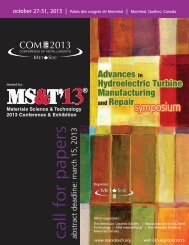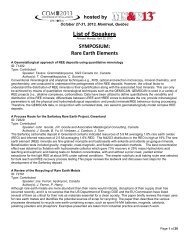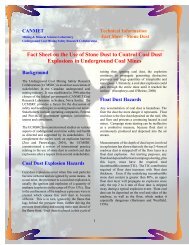hosted byOctober 27-31, 2013, Montreal, Quebec<strong>List</strong> <strong>of</strong> <strong>Speakers</strong>Revised: Monday, April 22, 2013<strong>SYMPOSIUM</strong>:<strong>Light</strong> <strong>Metals</strong> <strong>for</strong> <strong>Transportation</strong>sheet.This presentation discusses how FSW, in combination with SPF, can overcome these limitations. The interaction <strong>of</strong>multiple material and processing parameters effecting both FSW and SPF are examined and the resulting metallurgicaland mechanical properties are reviewed. Specific industrial applications will also be discussed.Synthesis <strong>of</strong> Al-TiB2 Nanocomposites Using High Frequency Induction MeltingID: 71726Type: ContributedSpeaker: A. M. Nabawy, Université du Québec à Chicoutimi, CanadaAuthor(s): A. Nabawy, X. ChenAluminum-based metal matrix composites rein<strong>for</strong>ced with nanoparticles can be widely used <strong>for</strong> high per<strong>for</strong>manceapplications in automotive and aerospace industries due to their light-weight and improved physical and mechanicalproperties. The use <strong>of</strong> electromagnetic stirring to assist the incorporation and dispersion <strong>of</strong> TiB2 nanoparticles in thealuminum melt was explored using a high frequency induction melting unit. The influence <strong>of</strong> processing parameters suchas the melting temperature and heating rate on the microstructure and mechanical properties was investigated. Fieldemission scanning electron microscope (FESEM), transmission electron microscope (TEM), and Clemex image analyzerwere used <strong>for</strong> the microstructure characterization. The results indicated that the synthesised Al-TiB2 nanocompositesdisplayed good incorporation and distribution <strong>of</strong> TiB2 nanoparticles throughout the aluminum matrix. The microhardness<strong>of</strong> nanocomposite materials was significantly improved compared to pure aluminum due the strong strengthening effect <strong>of</strong>TiB2 nanoparticles on the aluminum matrix.The Effect <strong>of</strong> Silicon on the Thermal Conductivity <strong>of</strong> Al-Si AlloysID: 70971Type: ContributedSpeaker: Nai-Kuang Tang, Metal Industries Research & Development Centre, TaiwanAuthor(s): N. TangElectric cars are the trend <strong>of</strong> vehicles. The electric motor, the key component <strong>of</strong> an electric car, with high power densityhas a serious problem <strong>of</strong> heat dissipation. Bad heat dissipation will cause the motor short life and low efficiency. Theconductivity <strong>of</strong> the material <strong>of</strong> the motor housing has great influence on heat dissipation. In order to develop a new diecastaluminum alloy with higher thermal conductivity so that the motor could have better heat dissipation, we firstresearched the effect <strong>of</strong> silicon on the thermal conductivity <strong>of</strong> Al-Si alloys as a basis <strong>for</strong> developing a new die-castaluminum alloy.In this paper we investigated the thermal conductivity <strong>of</strong> Al-Si alloys containing 4~14wt% <strong>of</strong> silicon. First,Al-Si alloy specimens with different percents <strong>of</strong> silicon were prepared. Then, we measured the thermal conductivity, andanalyzed the microstructure to build a model <strong>of</strong> predicting the thermal conductivity <strong>of</strong> Al-Si alloys.The Effect <strong>of</strong> Temperature on the Formability <strong>of</strong> a High Strength Aluminium Automotive AlloyID: 72177Type: ContributedSpeaker: Ross Nolan, University <strong>of</strong> Manchester, United KingdomAuthor(s): R. Nolan, P. Prangnell, J. Quinta da Fonseca, M. KulasThe desire to reduce automotive weights is driven by a need to reduce CO2 emissions. As such to allow further weightreduction higher per<strong>for</strong>mance aluminium alloys are in demand <strong>for</strong> sheet metal body structures. Due to their high strengthto weight ratio 7xxx alloys are seen as the ideal candidate <strong>for</strong> this, however their use to date has been limited by poor<strong>for</strong>mability. The <strong>for</strong>mability <strong>of</strong> a 7xxx candidate alloy, 7021, has been assessed by way <strong>of</strong> tensile testing and deepdrawing experimentation, both at room temperature and over an elevated temperature range. The <strong>for</strong>mability <strong>of</strong> the alloyimproved as the temperature was increased due to the lower flow stress experienced by the material during drawing.Page 14 <strong>of</strong> 17
hosted byOctober 27-31, 2013, Montreal, Quebec<strong>List</strong> <strong>of</strong> <strong>Speakers</strong>Revised: Monday, April 22, 2013<strong>SYMPOSIUM</strong>:<strong>Light</strong> <strong>Metals</strong> <strong>for</strong> <strong>Transportation</strong>Microstructural analysis <strong>of</strong> samples post-<strong>for</strong>ming showed a dimpled fracture surface with dimple size increasing withtemperature. Voids close to the surface were shown to initiate at Fe-containing particles.The Effects <strong>of</strong> Mg, Mo and Cr on the Microstructure and Elevated Temperature Mechanical Properties <strong>of</strong> an Al-Si-Cu-Mg Engine AlloyID: 71759Type: StudentSpeaker: Amir Rezaei Farkoosh, McGill University, CanadaAuthor(s): A. Rezaei Farkoosh, X. Chen, M. PekguleryuzHigh temperature Al-Si casting alloys are on the way to becoming an appropriate replacement <strong>for</strong> cast iron in Dieselengines. As a result <strong>of</strong> improvements in engine per<strong>for</strong>mance and demands <strong>for</strong> higher pressures and temperatures, theexisting aluminum alloys have reached strength limits. This has triggered ef<strong>for</strong>ts in alloy development to design Al alloyswith enhanced elevated-temperature per<strong>for</strong>mance. In the present work, the influence <strong>of</strong> Mg, Mo and Cr modifications onthe solidification, precipitation and elevated temperature mechanical properties <strong>of</strong> a Sr-modified Al7Si0.5Cu0.3Mg (inwt.%) alloy has been investigated. It is observed that the strength increases with increased Mg alloying. The presence <strong>of</strong>Mo leads to nano-scale dispersoid <strong>for</strong>mation which results in improved high-temperature strength, creep resistance andaging response.Thermodynamic Database <strong>for</strong> Copper Production and TreatmentID: 71690Type: StudentPosterSpeaker: Denis Shishin, Ecole Polytechnique <strong>of</strong> Montreal, CanadaAuthor(s): D. ShishinModern cars, trucks and trains are “computers on wheels”. No electronics is possible without copper, amazing metal withunique properties. It is also considered a perspective additive <strong>for</strong> light alloys. This presentation focuses on the creation <strong>of</strong>the large thermodynamic database <strong>for</strong> copper production and treatment. This database, created <strong>for</strong> use by FactSages<strong>of</strong>tware, covers the Al-Ca-Cu-Fe-Mg-Ni-O-S-Si chemical system and the following phases: liquid metal, slag, oxysulfidematte, spinel, numerous metallic, oxide and sulfide solid solutions.The Calphad-style optimization procedure is usedduring the database development. All available thermodynamic and phase diagram data are evaluated simultaneously inorder to obtain one set <strong>of</strong> model equations <strong>for</strong> the Gibbs energies <strong>of</strong> all phases as functions <strong>of</strong> temperature andcomposition. From these equations, all <strong>of</strong> the thermodynamic properties and the phase diagrams can be back-calculated.In this way, all the data are rendered self-consistent and consistent with thermodynamic principles.Thermodynamic Modeling and Optimization <strong>of</strong> the Al-Mn-Zn SystemID: 73861Type: PosterSpeaker: Chander Shekhar, Concordia University, CanadaAuthor(s): C. Shekhar, M. MedrajThe paper presents accurate and consistent thermodynamic description <strong>of</strong> Al-Mn-Zn ternary system and reportedconstituent ternary phases. Three intermetallic ternary compounds and increased solubility limits <strong>of</strong> the component binarycompounds were considered in the modeling. Among the ternary intermetallic compounds, t3 having complex solubilityrange has been modeled using compound energy <strong>for</strong>mulism whereas t1 and t2 have been considered as thestoichiometric phases. Along the binaries, models based on compound energy <strong>for</strong>mulism have been developed <strong>for</strong>constituent binary system to accommodate recently experimentally obtained solubility ranges. Liquid phase in the systemhas been modeled using Modified Quasi-chemical Model. The results from the experiments were compared with thePage 15 <strong>of</strong> 17
- Page 1 and 2: hosted byOctober 27-31, 2013, Montr
- Page 3 and 4: hosted byOctober 27-31, 2013, Montr
- Page 5 and 6: hosted byOctober 27-31, 2013, Montr
- Page 7 and 8: hosted byOctober 27-31, 2013, Montr
- Page 9 and 10: hosted byOctober 27-31, 2013, Montr
- Page 11 and 12: hosted byOctober 27-31, 2013, Montr
- Page 13: hosted byOctober 27-31, 2013, Montr
- Page 17: hosted byOctober 27-31, 2013, Montr


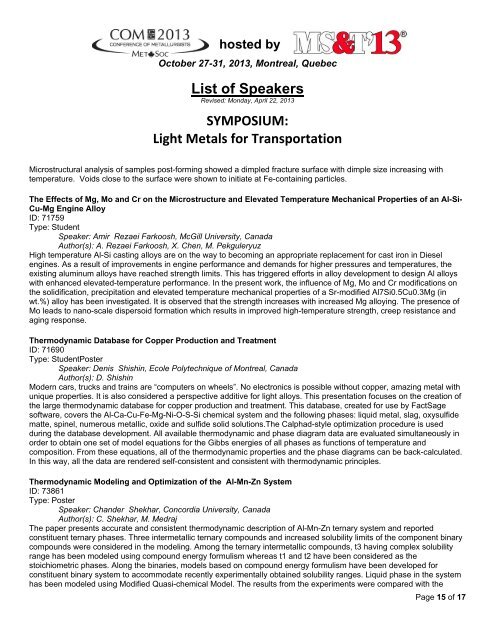

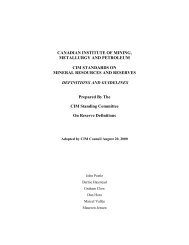
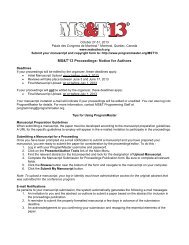


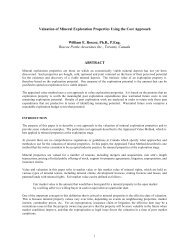
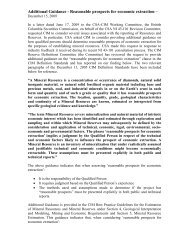
![Richard Wright - NORWEST Corporation [PDF]](https://img.yumpu.com/34320526/1/190x245/richard-wright-norwest-corporation-pdf.jpg?quality=85)
